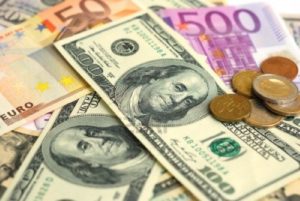 Yesterday’s trade saw EUR/USD within the range of 1.0874-1.0977. The pair closed at 1.0875, shedding 0.32% on a daily basis. It has been the 8th drop in the past 13 trading days. The daily high was a lower-high test of the high from January 15th.
Yesterday’s trade saw EUR/USD within the range of 1.0874-1.0977. The pair closed at 1.0875, shedding 0.32% on a daily basis. It has been the 8th drop in the past 13 trading days. The daily high was a lower-high test of the high from January 15th.
At 7:12 GMT today EUR/USD was up 0.37% for the day to trade at 1.0915. The pair touched a daily high at 1.0918 at 7:10 GMT and a daily low at 1.0868 during the early hours of the Asian trading session. Resistance may be expected at the high from January 20th (1.0977) and then – within the 1.0990-1.1005 area, where the pair encountered resistance on several occasions in the past two months. Support, on the other hand, may be received at the hourly 200-period EMA (1.0889).
On Thursday EUR/USD trading may be influenced by a number of macroeconomic reports and other events as listed below.
Fundamentals
Euro area
ECB policy decision and press conference
At 12:45 GMT the European Central Bank (ECB) is to announce its decision in regard to borrowing costs. The median estimate by experts suggests that the central bank will probably leave its benchmark interest rate intact at the record low level of 0.05% at the policy meeting today. The bank last reduced the refinancing rate by 10 basis points to the current 0.05% at the September 4th 2014 meeting.
At its meeting on December 2nd-3rd the central bank kept the marginal lending facility rate intact at 0.30%, but reduced the deposit facility rate by 10 basis points to -0.30%. Since March 2015 the bank has been implementing its public and private sector asset purchasing program at the amount of EUR 60 billion per month, which is intended to run until at least March 2017. The December Monetary Policy Accounts revealed that there were ECB policy makers who favored a larger cut in the deposit facility rate and also an expansion in the volume of monthly asset purchases.
According to extracts from the most recent Account of the policy meeting of the ECBs Governing Council: ”…while euro area inflation was expected to pick up, there had been a further deterioration in the outlook for inflation, so that the return to inflation rates below, but close to, 2% would likely take longer than previously expected. The risks surrounding the outlook for HICP inflation were also assessed, on balance, to remain on the downside.”
”…most members supported the set of policy measures proposed by Mr Praet, while some members did not, on balance, see a sufficient case for further policy action or were only prepared to support some of the elements put forward. Among the latter, a few members expressed a preference, if further accommodation was seen as warranted, for limiting policy action at the current meeting to a cut in the deposit facility rate, possibly going beyond the 10 basis point reduction that had been proposed and possibly also including the prolongation of fixed rate full allotment tender procedures.”
”A cut in the deposit facility rate of 10 basis points was seen as unlikely to trigger material negative side effects and was also seen as having the advantage of leaving some room for further downward adjustments, should the need arise.”
”At the same time, some members expressed a preference for a 20 basis point cut in the deposit facility rate at the current meeting, mainly with a view to strengthening the easing impact of this measure and reflecting the view that, to date, no material negative side effects on bank margins and financial stability had emerged.”
”The possibility was also raised of expanding the monthly volume of purchases or, alternatively, of frontloading purchases within the envisaged envelope so as to strengthen the impact in the short term. Moreover, the option was raised of extending the horizon beyond the suggested six months, so as to increase the overall volume of purchases above the level suggested by Mr Praet. However, there was broad agreement that such measures would not be warranted at this juncture, while a reassessment could be made in future.”
The interest rate decision is to be followed by the press conference with ECB President Mario Draghi, during which volatility of euro crosses usually heightens. In case Draghi offers a more hawkish tone, the euro will usually receive support, while a more dovish tone will have a bearish effect on the currency. The press conference is scheduled at 13:30 GMT.
Consumer Confidence Index – preliminary reading
Confidence among consumers in the Euro area probably improved in January. The preliminary value of the consumer confidence index probably advanced to -5.0 from a final value of -5.7 in December. The latter was a confirmation of the preliminary index reading reported on December 21st. If expectations were met, Januarys level of confidence would be the highest since April 2015. Back then the gauge was reported at a final -4.6. The index measures consumer confidence on a scale of -100 to +100. A reading of -100 suggests a lack of confidence, zero means neutrality and a reading of +100 indicates extreme levels of confidence. The index reflects the level of optimism, which consumers have about economic development in the region. The Business and Consumer Survey is conducted by phone and includes 23 000 households in the Euro area. The questions asked stress on current economic and financial situation, savings intention and also on expected developments regarding consumer price indexes, general economic situation and major purchases of durable goods. This indicator is one of the five major components, that comprise the Economic Sentiment Indicator (ESI).
Higher confidence usually implies a greater willingness to spend, including large-ticket purchases, while consumer spending is among the key factors driving economic growth. Therefore, in case the consumer confidence index improved more than anticipated, this would cause a moderate bullish impact on the euro. The European Commission is expected to release the preliminary reading at 15:00 GMT.
United States
Initial, Continuing Jobless Claims
The number of people in the United States, who filed for unemployment assistance for the first time during the business week ended on January 15th, probably dropped to 278 000, according to market expectations, from 284 000 reported in the preceding week.
The 4-week moving average, an indicator lacking seasonal effects, was 278 750, marking an increase by 3 000 compared to the preceding weeks unrevised average.
The business week, which ended on January 8th has been the 44th consecutive week, when jobless claims stood below the 300 000 threshold, which implied a healthy labor market.
Initial jobless claims number is a short-term indicator, reflecting lay-offs in the country. In case the number of claims met expectations or decreased further, this would have a moderate bullish effect on the US dollar.
The number of continuing jobless claims probably fell to the seasonally adjusted 2 248 000 during the business week ended on January 8th from 2 263 000 in the preceding week. The latter has been the highest number of claims since the business week ended on August 15th 2015. The figure also represented an increase by 29 000 compared to the revised up number of claims reported in the week ended on December 25th. This indicator reflects the actual number of people unemployed and currently receiving unemployment benefits, who filed for unemployment assistance at least two weeks ago.
The Department of Labor is to release the weekly report at 13:30 GMT.
Philadelphia Fed Manufacturing Survey
The Philadelphia Fed Manufacturing Index probably remained in negative territory for a second consecutive month in January, coming in at a reading of -3.0, according to the median forecast by experts. In December the gauge plunged to -5.9, or the lowest since August 2015, when it was reported at -6.0. The index is based on a monthly business survey (the Business Outlook Survey), measuring manufacturing activity in the third district of the Federal Reserve, Philadelphia. Participants give their opinion about the direction of business changes in overall economy and different indicators of activity in their companies, such as employment, working hours, new and existing orders, deliveries, inventories, delivery time, price etc. The survey is conducted every month since May 1968. The results are presented as the difference between the percentages of positive and negative projections. A level above zero is indicative of improving conditions, while a level below zero is indicative of worsening conditions. Higher-than-expected index readings would usually have a moderate bullish effect on the greenback. The Federal Reserve Bank of Philadelphia is expected to release the official results from the survey at 13:30 GMT.
Daily and Weekly Pivot Levels
By employing the Camarilla calculation method, the daily pivot levels for EUR/USD are presented as follows:
R1 – 1.0884
R2 – 1.0894
R3 (range resistance) – 1.0903
R4 (range breakout) – 1.0932
S1 – 1.0866
S2 – 1.0856
S3 (range support) – 1.0847
S4 (range breakout) – 1.0818
By using the traditional method of calculation, the weekly pivot levels for EUR/USD are presented as follows:
Central Pivot Point – 1.0902
R1 – 1.1002
R2 – 1.1086
R3 – 1.1186
S1 – 1.0818
S2 – 1.0718
S3 – 1.0634





